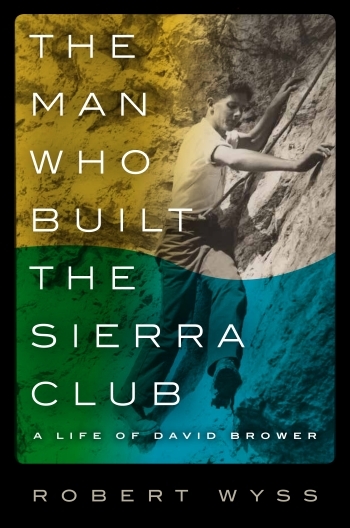An Interview with Robert Wyss, author of "The Man Who Built the Sierra Club"
“[David] Brower was a true bellwether, a man ahead of his time.”—Robert Wyss
The following is an interview with Robert Wyss, author of The Man Who Built the Sierra Club: A Life of David Brower:
Question: What was the status of the environmental movement when David Brower began as the head of the Sierra Club in 1953?
Robert Wyss: Weak. It was called the conservation movement and there was a plethora of volunteer organizations from (women’s) garden clubs to professional science organizations to a very few broad based groups like Audubon. But only a handful employed even a single full-time employee. Brower was the first at the Sierra Club. Washington D.C. was also far smaller in those days so it was possible for either prominent volunteers of these organizations (or their paid directors) to meet and have personal relationships with people who headed the U.S. Forest Service and the National Park Service. But they had very little clout in Congress. In contrast, a little known agency such as the U.S. Bureau of Reclamation for decades made massive changes in America’s landscape by erecting these massive dams. Dams created jobs and both voters and Congress appreciated those federal dam builders.
Q: How did Brower’s approach to environmental conservation differ from others?
RW: Brower was absolutely fearless. While his colleagues refused to directly challenge the Bureau of Reclamation, Brower took them on and soon he was also criticizing the Forest Service and even those who should have been his friends running the national parks. The incident that first began to build Brower’s national reputation occurred during the fight to oppose the construction of two dams in Dinosaur National Monument. Reclamation officials had made a very basic math mistake in their calculations to justify the dams but it dealt with an arcane issue few understood. Engineers told Brower that while the mistake was obvious, it would be foolhardy to confront Reclamation. No one would believe the dam builders made such a mistake. Brower ignored the advice, he publicly confronted the Bureau in a Congressional hearing, and ultimately Reclamation engineers backed down. Such reckless, plucky daring can be found throughout Brower’s career.
Q: How did he change the Sierra Club from the mission set by John Muir?
RW: John Muir founded the club in 1892 to encourage his friends in the greater San Francisco area to hike and camp in the Sierra Nevada mountains. Muir was a pretty radical conservationist for his era, but after he died in 1914 the club became politically conservative. It was a California-based hiking and social club that preferred to work through gentlemanly channels to protect natural resources. That was changing after World War II when a new, younger board of directors hired Brower. Brower expanded the club’s focus nationally and it became increasingly confrontational. Older members were immediately uncomfortable with this approach and as Brower (over the years) became more radical he began to lose the support that would contribute to his firing in 1969. But in many respects Brower was only following in the footsteps of Muir. They both strongly believed in protecting natural resources over anything else.
Q: How did Brower’s views on environmental activism change over his lifetime?
RW: There were two threads. One was that he became increasingly confrontational and less prone to compromise about the environment. The second was that he began to realize that all of these great places he was trying to protect were interrelated, often on a global scale. When Brower first took over at the Sierra Club he agreed to a compromise. In return for not building the two dams at Dinosaur, Brower acquiesced to building Glen Canyon Dam. Only after construction had begun did he discover the priceless geological features that would eventually be buried under hundreds of feet of water at Lake Powell. I think Glen Canyon changed him forever. No longer would he compromise. His more global viewpoint in protecting the environment developed in the late ’60s and matured over the next twenty years. Hardly anyone gives Brower the credit for this, but in the early 1970s he helped foster many of the first environmental organizations in Europe, Africa and Asia. Eventually his focus broadened to issues such as nuclear disarmament and that approach became too broad and diffuse to be effective. But Brower was a true bellwether, a man ahead of his time.
Q: What does is his legacy mean to today’s environmental movement?
RW: I believe only John Muir and Henry David Thoreau had a greater impact on today’s environmental movement than David Brower. Brower established the framework for environmental activism. He set down the political boundaries and philosophy, pointing out that once a natural treasure was lost, it could never be recovered. He also showed how to use propaganda effectively. He produced beautiful nature books with photographs by Ansel Adams and Eliot Porter. He published newspaper advertisements that were so influential that they flooded Congress with hundreds of thousands of letters. Why then is Brower not more of a household name? Well, he was cantankerous, confrontational and impossibly stubborn. He was a terrible financial manager and it was as much his mismanagement as his political views that led to his firing from the Sierra Club in 1969. That was a tragedy. I believe that if he could have somehow controlled his arrogance and worked with some of his critics he could have led the environmental movement the way Martin Luther King Jr. headed the civil rights campaign. But that was not David Brower and it is what makes reading about him so endlessly fascinating.





1 Response